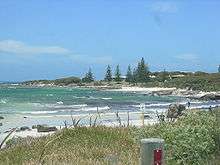Flinders Bay
Flinders Bay is a bay and locality that is immediately south of the townsite of Augusta, Western Australia, and close to the mouth of the Blackwood River and lies to the north east of Cape Leeuwin.
Bay
Flinders Bay (34° 21' 00S. 115° 20' 00E)
On Matthew Flinders Terra Australis Sheet 1 1801-1803 the area was originally known as Dangerous Bight. The bay runs from Point Matthew 1.5 km East North East of Cape Leeuwin to Ledge Point some 8 km east. It was named by either James Stirling or Septimus Roe in 1829 or 1830. Matthew Flinders was first in the Bay on 7 December 1801.

Railway terminus and jetty
The name of the locality of Flinders Bay is tied to the small settlement that had been a whaling and fishing location, as well as the terminus of the Busselton to Flinders Bay Branch Railway railway line (1920s, closed 1957), and the earlier Flinders Bay jetty (1890s). The settlement was in the earlier days considered to be separate from Augusta but now is more or less the southern portion of the larger community.
Boat harbour
The need for safe, and efficient transfer of whale watchers, and a safe mooring location in the Bay for fishermen has seen a proposal for a marina in 2004 which had included plans for the marina close to the old settlement of Flinders Bay. The 2005 revised proposal has moved to a bay further around towards Cape Leeuwin. The Flat Rock site is now under development and has been called 'Augusta Boat Harbour' by the department of Transport [1]

Whaling
The landing area adjacent to the old railway station yard, was original known as The Whaling. It was the area where boats would work from in the nineteenth and early twentieth century. Up until the early 1970s sheds and ramps were still present. In the late 20th century the area had Whale rescue operations occurring very close to the area. Also businesses involved in Whale watching have more recently used the bay.
Islands
The St Alouarn Islands stretch out south of Point Matthew (on the road to Cape Leeuwin), and are effective barriers along with reefs for the outer reaches of the bay to the south.
Climate
Like the majority of the southwestern coastal regions of Western Australia, Flinders Bay experiences a cool-summer Mediterranean climate with cool to warm summers and mild, wet winters.
Abalone sea ranch
After trials in 2012,[2] a world-first commercial "sea ranch" was set up in the Bay, to raise abalone. The ranch is based on an artificial reef made up of 5000 (as of April 2016) separate concrete units called abitats (abalone habitats). The 900-kilogram (2,000 lb) abitats can host 400 abalone each. The reef is seeded with young abalone from an onshore hatchery.
The abalone feed on seaweed that has grown naturally on the abitats. The ecosystem enrichment of the bay also results in growing numbers of dhufish, pink snapper, wrasse, samson fish and other species.
Brad Adams, from the company, has emphasised the similarity to wild abalone and the difference from shore based aquaculture. "We're not aquaculture, we're ranching, because once they're in the water they look after themselves."[3][4]
Notes
- ↑ http://www.transport.wa.gov.au/imarine/23469.asp#intro Augusta Boat Harbour
- ↑ "Information Memorandum, 2013 Ranching of Greenlip Abalone, Flinders Bay – Western Australia" (PDF). Ocean Grown Abalone. Ocean Grown Abalone. Retrieved 23 April 2016.
- ↑ Fitzgerald, Bridget (28 August 2014). "First wild abalone farm in Australia built on artificial reef". Australian Broadcasting Corporation Rural. Australian Broadcasting Corporation. Retrieved 23 April 2016.
It's the same as the wild core product except we've got the aquaculture advantage which is consistency of supply.
- ↑ Murphy, Sean (23 April 2016). "Abalone grown in world-first sea ranch in WA 'as good as wild catch'". Australian Broadcasting Corporation News. Australian Broadcasting Corporation. Retrieved 23 April 2016.
So to drive future growth I really believe sea ranching is a great opportunity going forward for some of these coastal communities.
References
- Fornasiero, Jean; Monteath, Peter and West-Sooby, John. Encountering Terra Australis: the Australian voyages of Nicholas Baudin and Matthew Flinders, Kent Town, South Australia,Wakefield Press,2004. ISBN 1-86254-625-8
| Wikimedia Commons has media related to Flinders Bay. |
- DLI Geographic names cards
Coordinates: 34°21′S 115°20′E / 34.350°S 115.333°E